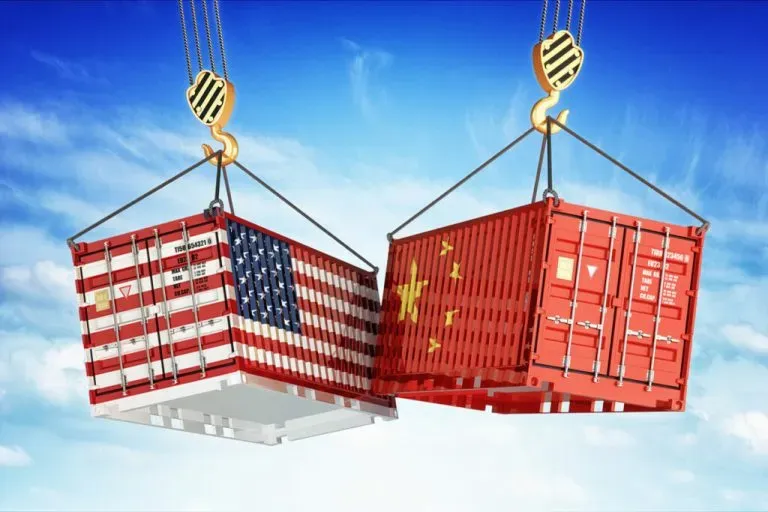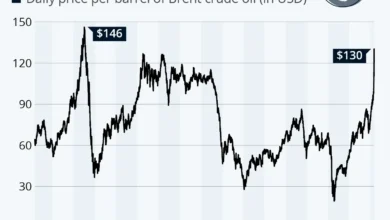China US Tariffs: Escalation in the Trade War

The recent developments surrounding China US tariffs have escalated tensions in the already fraught landscape of international trade. As China prepares to impose a staggering 34% tax on all U.S. imports, this move signifies a critical moment in the broader US trade war initiated by President Trump. These retaliatory actions come in light of previous tariffs on Chinese goods, which aimed to address allegations covering a multitude of issues from trade deficits to intellectual property theft. Beijing’s swift and formidable response, underscored by retaliatory tariffs and bans on key imports, reinforces the growing impacts of tariffs on the economy of both nations. As both superpowers navigate this complex landscape, the ramifications on global markets and trade relationships are becoming increasingly pronounced.
Amid the ongoing economic strife, the imposition of hefty tariffs by China on American goods marks a significant chapter in the saga of US-China trade relations. This conflict, often referred to as the trade war, has seen both nations imposing retaliatory measures that have far-reaching consequences. The recent actions by Beijing not only reflect heightened tensions but also signal a pivotal shift in economic strategy, as both sides grapple with the economic fallout. With accusations and countermeasures flying, these retaliatory tariffs are reshaping the global trade landscape and inviting scrutiny from analysts around the world. The unfolding situation raises important questions about the future of international trade and the essential commodities at its core.
The Impact of China US Tariffs on Trade Relations
The recent announcement by China to impose a 34% tax on all U.S. imports signifies a critical moment in the ever-evolving landscape of the China US tariffs. This action marks a significant escalation in the ongoing US trade war, which has seen a series of retaliatory measures exchange between the two economic giants. The tariffs aim to match the intensity of previous U.S. tariffs imposed on Chinese products, illustrating how both countries are locked in a tit-for-tat strategy that threatens the stability of global trade. As Beijing implements these tariffs, it raises the stakes not only for American exporters but also for the Chinese economy, which relies heavily on U.S. imports.
The ramifications of these China US tariffs extend far beyond immediate trade. They pose severe implications for multinational corporations that operate within both countries, leading to increased unpredictability in supply chains and international investments. Companies that depend on the uninterrupted flow of trade are forced to reassess their strategies, as tariffs can alter pricing structures and profit margins. Moreover, consumers in both nations may face higher prices and reduced choices as industries grapple with the financial burden of tariffs, potentially leading to a slowdown in economic growth.
Beijing’s Retaliatory Tariffs and Their Economic Effects
Beijing’s introduction of retaliatory tariffs, such as the substantial 34% tax on U.S. imports, exemplifies its strategy to respond to the pressures of the Trump China trade conflict. The Chinese government’s measures signify a shift towards a more aggressive stance, reflecting dwindling optimism for reaching a peaceful resolution through negotiation. These retaliatory tariffs are not merely punitive; they are calculated to exert economic pressure on the U.S. by impacting sectors that are crucial for American businesses and workers. The targeted approach, including the suspension of imports from U.S. companies on dubious health grounds, showcases Beijing’s determination to leverage trade policy in the face of U.S. aggression.
The economic effects of these Beijing retaliatory tariffs are already being felt, with immediate consequences visible in financial markets. The U.S. stock market plunged following the announcement of the new tariffs, indicating investor anxiety regarding future trade relations. Furthermore, the escalating tensions could lead to longer-term consequences for the global economy, particularly in industries that rely on cross-border trade. As businesses adapt to a new tariff landscape, we may witness shifts in manufacturing locations, investment flows, and even consumer behavior, as companies and individuals search for alternatives to mitigate the cost hikes associated with tariffs.
Understanding the US Trade War’s Broader Consequences
The US trade war with China, characterized by a series of escalating tariffs and retaliatory measures, has broader consequences that transcend mere financial calculations. This conflict has the potential to redefine global supply chains and trade partnerships, as nations unsatisfied with U.S. policies may seek alternatives or forge new alliances. Furthermore, the uncertainty surrounding the trade conflict hampers long-term economic planning for companies on both sides, leading to a reluctance to invest and innovate as businesses navigate these treacherous waters.
In addition to affecting trade agreements, the US trade war has implications for geopolitical dynamics. The economic consequences of tariffs can propel nations to rethink dependencies and trade relationships. Countries might prioritize diversification, seeking to reduce their reliance on U.S. markets. This transformative period highlights the interconnectedness of global economies, where tariffs can ripple through to various sectors, affecting employment rates and consumer behaviors worldwide.
The Role of Trump in the China Trade Conflict
Former President Trump’s administration played a pivotal role in igniting the China trade conflict, marked by aggressive tariffs on Chinese imports. His rationale for imposing these tariffs often cited national security concerns and China’s trade practices, which he claimed were unfairly disadvantaging American workers. Trump’s stance aimed to resonate with voters who felt neglected by globalization, framing the tariffs as necessary to protect U.S. manufacturing jobs and restore America’s economic power on the global stage.
Despite the populist appeal of Trump’s trade policy, the ramifications of his decisions have sparked intense debate. Supporters argue that his tough stance on tariffs is crucial for negotiating better trade terms while critics warn that these measures could lead to economic retaliation, increased prices for consumers, and potential job losses in sectors reliant on trade. As the dust settles from Trump’s trade initiatives, the long-term outcomes of these policies remain a critical area of concern for economists and policymakers.
Beijing’s Stance on Trade with the US
Beijing’s approach to trade with the U.S. is heavily influenced by its strategic interests and the need to maintain economic stability. As the trade war intensifies, the Chinese leadership has resorted to implementing a series of tariffs and export controls aimed not only at retaliating against U.S. actions but also at showcasing its resolve. This firm stance emphasizes China’s position as a global economic powerhouse that is willing to defend its trade practices and interests vigorously against perceived aggression.
The Chinese government’s sustained rhetoric around the trade conflict reflects a broader strategy to project confidence and strength. By showcasing retaliatory measures like the 34% tariffs on U.S. imports, China communicates its willingness to withstand pressure from the U.S. despite the associated economic risks. This approach is designed to foster a narrative of unity and resilience among domestic audiences while sending a clear message to the international community about its commitment to leveling the economic playing field.
Long-Term Implications of the Tariffs on Global Economy
The long-term implications of the current tariff landscape, especially between the U.S. and China, are profound for the global economy. As these countries engage in a persistent trade conflict, the resulting barriers to trade could prompt reconfiguration of global supply chains. Companies may begin to relocate production to countries that offer more favorable trade terms or consider diversifying their markets to mitigate the risks associated with high tariffs. This trend could foster new trade networks and partnerships, potentially reshaping economic alliances globally.
Beyond immediate financial effects, the ongoing trade war provokes questions about the future of global economic policies. Nations might become more protective or isolationist as they navigate similar scenarios, leading to a fragmented international trading system. The enduring nature of such tariffs could have cascading repercussions, affecting currencies, international investments, and overall economic growth rates in a myriad of countries engaged in commerce with the U.S. and China.
The Future of US-China Trade Relations
The future of US-China trade relations lies at a crossroads, with recent developments indicating a trend toward increased hostility rather than cooperation. As both nations continue to assert their positions—evidenced by ongoing tariff implementations and retaliatory actions—the possibility of reaching a comprehensive trade agreement seems increasingly remote. Analysts speculate that until there is significant diplomatic engagement or a shift in policy tone, the two countries will remain mired in a protracted cycle of tariffs and disputes.
However, the evolution of these relations does not solely depend on government actions; the roles of multinational corporations and their lobbying efforts can play a crucial part in reshaping the dialogue. Business leaders advocate for more stable and equitable trade relationships, recognizing that escalating tariffs ultimately hurt their bottom line. As pressures mount from the business sector, there may be renewed calls for negotiations that could alleviate some of the economic strain being felt by both American and Chinese firms.
Escalating Tensions: Trade Restrictions and Their Consequences
The escalating tensions between the U.S. and China have given rise to numerous trade restrictions, which pose significant risks to both economies. The imposition of tariffs, particularly Beijing’s recent measures against American imports, is perceived as a direct retaliation that can alter market dynamics substantially. Such restrictions lead to uncertainty within the marketplace, affecting consumer confidence and investment decisions across both nations. Stakeholders are increasingly wary of how these economic policies will influence their industries and operational strategies moving forward.
Consequently, the broader consequences of these trade restrictions may manifest as supply chain disruptions, increased costs, and diminished market access, compelling both sides to reconsider their respective economic policies. Sectors reliant on imports from China or the U.S. find themselves at a disadvantage as tariffs raise operating expenses. In the long run, continued implementation of such trade restrictions may lead to a broader economic downturn, showcasing just how interconnected and fragile the global economy remains in the face of rising nationalism and protectionism.
Navigating the Geopolitical Landscape Amidst Trade Tensions
Navigating the geopolitical landscape during these heightened trade tensions requires a careful approach from both the U.S. and China. With both nations wielding economic power as a form of leverage, the stakes are considerably high for global diplomacy and alliances. The approach taken by both governments could lead to strategic reshuffling in international relations, where countries may choose sides or seek collaborations based on shared economic interests or concerns over trade practices.
Amidst these trade tensions, international bodies, such as the World Trade Organization, may find themselves playing a more significant role in mediating disputes and ensuring that trade rules are adhered to. As trade partners look for guidance on navigating tariffs and retaliatory measures, the importance of multilateralism becomes increasingly paramount to foster an environment of cooperation and mitigate the risk of a fracturing global trade system.
Frequently Asked Questions
What are the current China tariffs on US imports?
As of the latest announcements, China has imposed a 34% tariff on all U.S. imports as part of its retaliatory measures against the U.S. trade war initiated by President Trump. This rate matches the tariffs that the U.S. has placed on Chinese goods, highlighting the reciprocal nature of tariffs in the China-US trade conflict.
How are the China US tariffs affecting the economy?
The impact of tariffs on the economy has been significant, causing stock market fluctuations and prompting U.S. businesses to reconsider their trade strategies. The escalation of the US-China trade war has also led to stricter export controls from China on essential goods, impacting sectors reliant on U.S. imports and potentially slowing economic growth for both nations.
What are Beijing’s retaliatory tariffs in response to US trade actions?
Beijing’s retaliatory tariffs include a 34% tax on U.S. imports and the suspension of imports from six U.S. companies. Additionally, China has investigated U.S. firms under anti-monopoly laws, and implemented broader restrictions on other goods, indicating a significant response to the ongoing Trump China trade conflict.
What is the relationship between the US trade war and the recent tariffs imposed by China?
The US trade war refers to the ongoing economic conflict between the U.S. and China, characterized by imposed tariffs and counter-tariffs. Recent tariffs imposed by China, which include a heavy 34% tax on U.S. goods, are a clear retaliatory measure against U.S. tariffs announced under President Trump’s administration, escalating tensions between the two economic giants.
What are the implications of Trump’s actions on China tariffs?
Trump’s tariffs have led to a tit-for-tat escalation in the China US tariffs situation, intensifying the trade war. China’s retaliatory tariffs are indicative of strategic economic responses, which may further alienate U.S.-China relations and create instability in global markets, impacting businesses and international trade.
Are there specific sectors affected by the increased China tariffs on US imports?
Yes, specific sectors have been heavily impacted by the increased China tariffs on US imports, particularly in agriculture, technology, and manufacturing. Restrictions on U.S. agricultural goods, combined with tariffs on high-tech exports, signal a broad impact across industries impacted by Beijing’s retaliatory tariffs.
How does the US-China trade conflict influence global trade dynamics?
The US-China trade conflict significantly influences global trade dynamics by challenging traditional trade relationships and encouraging countries to reconsider their supply chains. As tariffs increase, businesses are seeking alternatives, thus reshaping trade policies and economic partnerships worldwide, indicating a potential shift in global market alignments.
What measures is China taking in response to the US trade war?
In response to the US trade war, China is implementing various measures, including imposing retaliatory tariffs, suspending imports from certain U.S. businesses, and increasing export controls on vital materials. These actions are aimed at counteracting the economic pressure exerted by U.S. tariffs and assert China’s stance in international trade.
| Key Point | Details |
|---|---|
| China’s Retaliatory Tariff Rate | China will impose a 34% tax on all U.S. imports next week, mirroring the U.S. tariffs. |
| Previous U.S. Tariffs | Trump implemented two rounds of 10% tariffs on Chinese goods due to allegations regarding the fentanyl crisis. |
| Impact on U.S. Stock Market | The U.S. stock market experienced a plunge following China’s retaliatory measures. |
| Stricter Export Controls | China has implemented stricter controls on rare earth minerals vital for technology. |
| Suspension of U.S. Imports | China suspended imports from six U.S. companies including poultry, sorghum, and bonemeal. |
| Antitrust Actions | Beijing initiated an anti-monopoly investigation into DuPont China Group. |
| Increase in Sanctions | An additional 11 U.S. companies were added to the unreliable entity list. |
| Military Dialogue Ongoing | Despite escalating tensions, military dialogue about maritime safety continues between both nations. |
Summary
China US Tariffs have escalated significantly as China announces a 34% tax on U.S. imports, responding to President Trump’s previously implemented tariffs. This tit-for-tat strategy reflects deepening tensions in trade relations, with both nations entrenching their positions. The implications of these tariffs extend beyond trade, influencing stock markets and international economic stability, marking a crucial chapter in the ongoing trade war.




